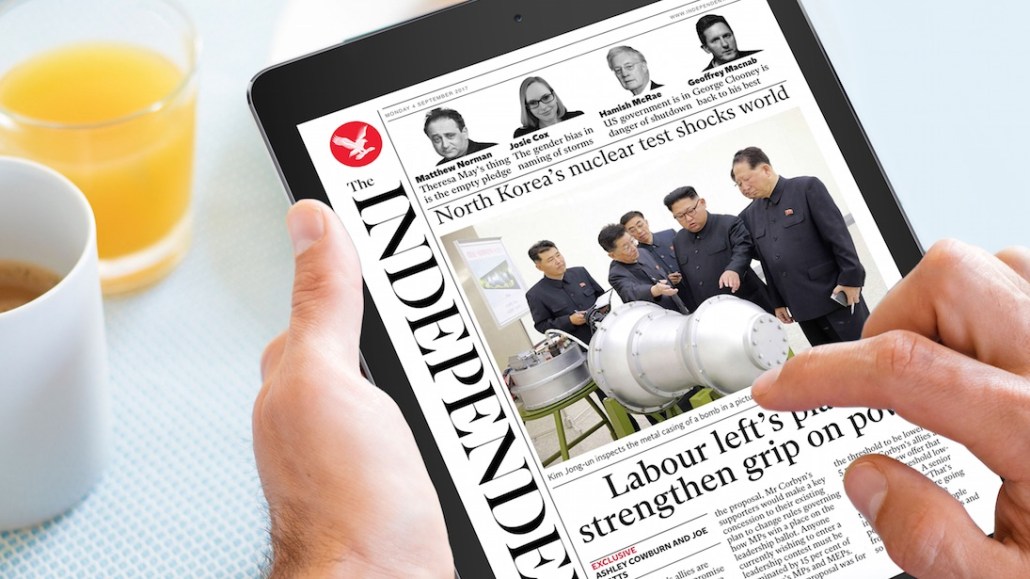The Independent and Evening Standard are giving marketers real-time editorial data

ESI Media, publisher of The Independent and the Evening Standard, is giving agencies access to data on its most popular articles in a bid to give advertisers more control over the ads they buy and to build deeper, longer-term relationships with them.
Once ESI Media grants access, the agencies can view a dashboard, ESI RealTime, of the publisher’s most popular articles across its portfolio, which also includes indy100 and Homes & Property. The dashboard pulls in Chartbeat data on the number of visitors to articles and dwell times, metrics that ESI Media, and other publishers, have used in their newsrooms for years. This can be sorted by publication, device, section (like travel, sport and business), location and referral. This way, a luxury advertiser can book ads against the most popular fashion articles that people in London are reading from social media.
An agency can make an inquiry about popular articles that meet an advertiser’s needs. A member of the ESI Media ad ops team then follows up on that request. Ads are booked across media and can be served direct or programmatically, so long as the advertiser’s request doesn’t clash with priority campaigns, like homepage or channel takeover.

“I would expect this to win us more business; I’m really bullish on that,” said Jo Holdaway, chief data officer at ESI Media, although she knows not everyone will use the dashboard to book. “It’s a point of difference to other media owners when it comes to long-term partners.”
Over the next few months, it’s running its first campaign with beer brand Kronenbourg and the brand’s agency Publicis, which requires a little more heavy lifting from the media owner. ESI Media analysts send the articles to ad buyers that are most likely to be read most and fall within the advertiser’s guidelines. Within two hours, the agency returns ad creative relevant to the article. Kronenbourg ads with relevant copy have run on articles about the eclipse and France’s president Emmanuel Macron. Currently, the brand is targeting the most popular articles around the football player transfer window.

A recent popular story about why Liverpool football club didn’t sell player Philippe Coutinho had 3,000 concurrent visitors who spent an average of 80 seconds with the article.
“The scale is not always huge, but the tightness of targeting is there,” said Holdaway. “If you book 2 million impressions across the top trending stories, I’d be surprised if you didn’t get that.” ESI Media’s properties have a total 23.5 million monthly unique visitors, out of a U.K. internet population of 50.5 million monthly unique visitors, according to comScore.
Articles about Brexit, Trump and sports events routinely do well, with Brexit content fetching average dwell times of about three minutes. Advertisers that don’t want ads to appear next to stories about terrorist attacks or other news stories can automatically de-list them. Because the ad buy is based on what people are reading, which isn’t necessarily predictable, it’s difficult for the publishers to give benchmarks or guarantees.
Holdaway couldn’t share figures on how well the ads were performing, as the campaign is still running. But she said early signs are encouraging, particularly the click-through rate on formats like its billboard and double MPU.
For now, only display ads are included in the available inventory, but in the next two months, the publisher hopes to include video pre-roll, too.
ESI Media’s tool should bring more flexibility to media buying. Campaigns like the one it’s running with Kronenbourg have a bespoke data element, which can help lead to longer-term relationships. “There’s been a halo effect beyond how the core product was designed,” said Holdaway.
More in Media

Media Briefing: ‘Cloudflare is locking the door’: Publishers celebrate victory against AI bot crawlers
After years of miserably watching their content get ransacked for free by millions of unidentified AI bot crawlers, publishers were finally thrown a viable lifeline.

Vogue faces new headwinds as Anna Wintour — who agency execs say made ad dollars flow — shifts focus
Anna Wintour’s successor at Vogue will have to overcome the myriad of challenges facing fashion media and the digital publishing ecosystem.

Here are the biggest misconceptions about AI content scraping
An increase in bots scraping content from publishers’ sites represents a huge threat to their businesses. But scraping for AI training and scraping for real-time outputs present different challenges and opportunities.







